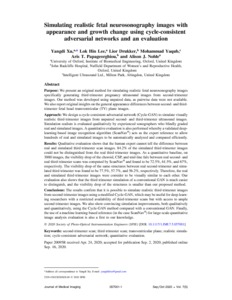Xu, Y; Lee, LH; Drukker, L; Yaqub, M; Papageorghiou, AT; Noble, AJ
(2020)
Simulating realistic fetal neurosonography images with appearance and growth change using cycle-consistent adversarial networks and an evaluation.
J Med Imaging (Bellingham), 7 (5).
057001.
ISSN 2329-4302
https://doi.org/10.1117/1.JMI.7.5.057001
SGUL Authors: Papageorghiou, Aris
![[img]](https://openaccess.sgul.ac.uk/114788/1.hassmallThumbnailVersion/JMI-007-057001.pdf)  Preview |
|
PDF
Published Version
Available under License ["licenses_description_publisher" not defined].
Download (2MB)
| Preview
|
Abstract
Purpose: We present an original method for simulating realistic fetal neurosonography images specifically generating third-trimester pregnancy ultrasound images from second-trimester images. Our method was developed using unpaired data, as pairwise data were not available. We also report original insights on the general appearance differences between second- and third-trimester fetal head transventricular (TV) plane images. Approach: We design a cycle-consistent adversarial network (Cycle-GAN) to simulate visually realistic third-trimester images from unpaired second- and third-trimester ultrasound images. Simulation realism is evaluated qualitatively by experienced sonographers who blindly graded real and simulated images. A quantitative evaluation is also performed whereby a validated deep-learning-based image recognition algorithm (ScanNav®) acts as the expert reference to allow hundreds of real and simulated images to be automatically analyzed and compared efficiently. Results: Qualitative evaluation shows that the human expert cannot tell the difference between real and simulated third-trimester scan images. 84.2% of the simulated third-trimester images could not be distinguished from the real third-trimester images. As a quantitative baseline, on 3000 images, the visibility drop of the choroid, CSP, and mid-line falx between real second- and real third-trimester scans was computed by ScanNav® and found to be 72.5%, 61.5%, and 67%, respectively. The visibility drop of the same structures between real second-trimester and simulated third-trimester was found to be 77.5%, 57.7%, and 56.2%, respectively. Therefore, the real and simulated third-trimester images were consider to be visually similar to each other. Our evaluation also shows that the third-trimester simulation of a conventional GAN is much easier to distinguish, and the visibility drop of the structures is smaller than our proposed method. Conclusions: The results confirm that it is possible to simulate realistic third-trimester images from second-trimester images using a modified Cycle-GAN, which may be useful for deep learning researchers with a restricted availability of third-trimester scans but with access to ample second trimester images. We also show convincing simulation improvements, both qualitatively and quantitatively, using the Cycle-GAN method compared with a conventional GAN. Finally, the use of a machine learning-based reference (in the case ScanNav®) for large-scale quantitative image analysis evaluation is also a first to our knowledge.
| Item Type: |
Article
|
| Additional Information: |
Copyright 2020 Society of Photo‑Optical Instrumentation Engineers (SPIE). One print or electronic copy may be made for personal use only. Systematic reproduction and distribution, duplication of any material in this publication for a fee or for commercial purposes, and modification of the contents of the publication are prohibited. |
| Keywords: |
cycle-consistent adversarial network, quantitative evaluation, realistic simulation, second-trimester scan, third-trimester scan, transventricular plane, second-trimester scan, third-trimester scan, transventricular plane, realistic simulation, cycle-consistent adversarial network, quantitative evaluation |
| SGUL Research Institute / Research Centre: |
Academic Structure > Institute of Medical & Biomedical Education (IMBE)
Academic Structure > Institute of Medical & Biomedical Education (IMBE) > Centre for Clinical Education (INMECE ) |
| Journal or Publication Title: |
J Med Imaging (Bellingham) |
| ISSN: |
2329-4302 |
| Language: |
eng |
| Dates: |
| Date | Event |
|---|
| 16 September 2020 | Published | | 2 September 2020 | Accepted |
|
| Publisher License: |
Publisher's own licence |
| Projects: |
|
| PubMed ID: |
32968691 |
| Web of Science ID: |
WOS:000590135500014 |
 |
Go to PubMed abstract |
| URI: |
https://openaccess.sgul.ac.uk/id/eprint/114788 |
| Publisher's version: |
https://doi.org/10.1117/1.JMI.7.5.057001 |
Statistics
Item downloaded times since 07 Sep 2022.
Actions (login required)
 |
Edit Item |



